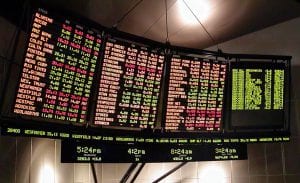
The Federal Reserve’s Inaction: A Recipe for Currency Debasement?
Updated May 2023
The Federal Reserve’s inaction can be seen as a tacit endorsement of these questionable activities, which can lead to a loss of confidence in the dollar. This loss of confidence can trigger a vicious cycle of currency debasement as investors and consumers seek to protect their wealth by investing in other assets, further driving down the value of the dollar.
Moreover, the Fed’s inaction can also lead to a misallocation of resources. When banks engage in risky activities with the knowledge that the Fed will not intervene, they are essentially being rewarded for their recklessness. This can lead to a distortion of the market, as resources are diverted away from productive activities and towards speculative ones.
A Deeper Look into Currency Debasement
The Federal Reserve first introduced the practice of quantitative easing (QE) in the wake of the 2008 financial crisis. Its initial purpose was to boost the economy by injecting large amounts of money into the financial system. However, as the years have gone by, it has become clear that QE is a permanent fixture in the Fed’s monetary policy arsenal. This has led some to dub it “forever QE.”
One of the most significant criticisms of QE is that it fosters boom and bust cycles. The Fed encourages risky investments and speculation by keeping interest rates artificially low and flooding the market with cheap money. This leads to asset bubbles, such as the housing bubble that burst in 2008, which in turn can trigger financial crises and economic recessions.
Moreover, the Fed’s reliance on QE has led to a phenomenon known as currency debasement. Essentially, as the Fed continues to print money and inflate the money supply, the value of the dollar decreases. As a result, the average American’s purchasing power decreases as the price of products and services rises over time.
Adding Fuel to the fire
To make matters worse, the US government is saddled with the interest rate risk on Silicon Valley Bank’s balance sheet to prevent its collapse. This view tells us that the Fed was and is always fully aware of the nonsense going on. If they don’t stop it, it’s because it’s part of their Machiavellian plan. Our standing case has always been that, besides fostering boom and bust cycles, the Fed’s other mission is to debase the currency. The currency race to the bottom continues with the objective being to finish last.
Factors that Influence the Fed’s Inaction
Moreover, the Fed’s regulatory powers have been weakened over time, making it difficult for them to intervene effectively in the financial system. This weakening of regulatory powers is due in part to political pressure and lobbying from powerful financial institutions. These institutions have a vested interest in maintaining the status quo, as it allows them to continue their risky activities with little to no oversight.
In addition, the Fed’s inaction can also be attributed to a fear of causing panic in the financial markets. The Fed is often caught in a delicate balancing act, trying to maintain stability in the financial system while also trying to prevent the formation of asset bubbles. However, this often leads to a policy of inaction, as the Fed is hesitant to take measures that could potentially destabilize the financial system.
The Fed’s Role in Creating Crises
Their rhetoric is just that. To be sure, they will make it appear that they are dead serious about the desired course of action, but at a certain point, they will trigger a crisis so they can provide a solution. In this case, it’s to make it appear as though they’re dead set on raising rates to fight inflation that they helped fuel in the first place. We could go on and on, but the crux of the matter is that as more money is created, they’ll have to turn up the pain dial. Why, you may ask? Well, when you have boatloads of money, it takes time to deploy into the market. There’s no such thing as a fair or free market, mate.
The Upward and Downward Phases of the Market
They should change the name and call it the killing fields, but then it wouldn’t sell so well, so the stock market will remain. After the COVID crash, the big players’ cash trove skyrocketed, so they needed a lot more time to deploy this money. We suspect they have so much money that it takes months to deploy. This means it will take months on end to take out. So remember, the upward phase will be just as wild as the downward phase. In other words, these markets will eventually trade in the overbought ranges for a very long time. They knew these banks were having problems over a year ago, but they only sent them warning messages.
Andre Esteves, the co-founder and chairman of Banco BTG Pactual SA, and others share the view that even a junior analyst from Latin America could have managed the interest rate risk on Silicon Valley Bank’s balance sheet to prevent its collapse. This view tells us that the Fed was and is always fully aware of the nonsense going on. If they don’t stop it, it’s because it’s part of their Machiavellian plan. Our standing case has always been that, besides fostering boom and bust cycles, the Fed’s other mission is to debase the currency. The currency race to the bottom continues with the objective being to finish last.
Factors that Influence the Fed’s Inaction
Moreover, the Fed’s regulatory powers have been weakened over time, making it difficult for them to act decisively against banks. This is due to political pressure, deregulation, and the growing complexity of the financial system.
Another factor is the potential backlash from powerful financial institutions and political figures. When banks are influential or “too big to fail,” the Fed may hesitate to take action against them.
How Currency Debasement Can Result from the Federal Reserve’s Inaction
Lastly, the Fed may choose inaction to preserve its own reputation and credibility. By not intervening, the Fed avoids admitting that banks under its supervision are involved in illegal activities, which could damage the public’s trust in the Federal Reserve itself.
In conclusion, the Federal Reserve’s inaction regarding questionable bank activities is a recipe for currency debasement. This inaction is due to a combination of factors, including the prioritization of economic growth, weakened regulatory powers, potential backlash, and the preservation of the Fed’s reputation.
In conclusion, the Federal Reserve’s inaction regarding questionable bank activities is a recipe for currency debasement. This inaction is due to a combination of factors, including the prioritization of economic growth, weakened regulatory powers, potential backlash, and the preservation of the Fed’s own reputation and credibility. As a result, the average American consumer is left to bear the brunt of the Fed’s inaction, as they face higher prices and a decrease in their purchasing power.
FAQ on Currency Debasement
Q: What is the Federal Reserve’s role in maintaining stability in the financial system?
A: The Federal Reserve is responsible for maintaining stability in the financial system. However, its inaction regarding questionable activities carried out by banks has raised concerns about the Fed’s ability to fulfill its mandate effectively.
Q: What is currency debasement, and how is the Fed contributing to it?
A: Currency debasement is a phenomenon where the value of money declines due to an increase in the supply of money. The Fed’s inaction regarding questionable bank activities indirectly contributes to the currency’s devaluation.
Q: Why is the Fed hesitant to intervene in questionable bank activities?
A: The primary reason for the Fed’s inaction is its focus on maintaining economic growth and stability. The Fed is willing to tolerate questionable activities to avoid potential disruptions to the financial system arising from intervening. Additionally, the Fed’s regulatory powers have been weakened over time, making it difficult for them to act decisively against banks.
Q: What are the unintended consequences of the Fed’s inaction?
A: By not intervening, the Fed avoids admitting that banks under its supervision are involved in illegal activities, which could damage the public’s trust in the Federal Reserve itself. This could ultimately lead to currency debasement, inflation, and a decrease in purchasing power, ultimately hurting the average consumer.
Q: What factors influence the Fed’s inaction?
A: Factors that influence the Fed’s inaction include political pressure, deregulation, the growing complexity of the financial system, potential backlash from powerful financial institutions and political figures, and preserving the Fed’s reputation and credibility.
Q: What is the Fed’s other mission besides fostering boom and bust cycles?
A: Our standing case has always been that, besides fostering boom and bust cycles, the Fed’s other mission is to debase the currency. The currency race to the bottom continues, with the objective being to finish last.
A World of Ideas: Articles That Will Expand Your Horizons
Zero Percent Mortgages Debut: Setting the Stage for Next Bull Market
Brexit’s Currency Wars: Hidden Theme for Financial Freedom
Surviving the Bear Stock Market: What’s New for Investors?
Fed Interest Rate: Negative Rates Are A Game Changer
What Economic Recovery? Most Americans Lack $1000 In Savings
Federal Reserve Interest Rate: Dangers & Benefits of Negative Rates

Why Are Interest Rates So Low: Coronavirus That’s Why
CAT Stock Price Projections And Future Trends
Why own gold in uncertain times: Protection From Disaster
HD stock quote And future price trends
Valeant Shares Slump



